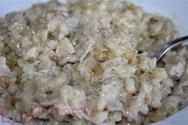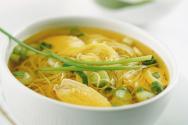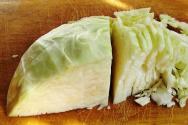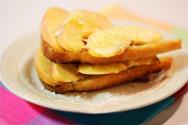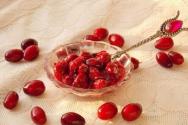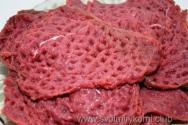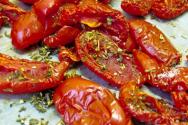Poisonous row mushrooms are talkers. Edible and inedible row mushrooms, use in cooking and beneficial properties Row mushroom how to distinguish poisonous
Taxonomy:- Division: Basidiomycota (Basidiomycetes)
- Subdivision: Agaricomycotina (Agaricomycetes)
- Class: Agaricomycetes (Agaricomycetes)
- Subclass: Agaricomycetidae (Agaricomycetes)
- Order: Agaricales (Agaric or Lamellar)
- Family: Tricholomataceae
- Genus: Tricholoma (Tricholoma or Ryadovka)
- View: Tricholoma pardinum (Poisonous row)
- Other names for the mushroom:
Synonyms:
Leopard print row
- Agaricus unguentatus
- Tricholoma unguentatum
First officially described by Christiaan Hendrik Persoon in 1801, Tricholoma pardinum has a complex taxonomic history that spans over two centuries. In 1762, the German naturalist Jacob Christian Schäffer described the species Agaricus tigrinus with an illustration consistent with what was thought to be T. pardinum, and consequently the name Tricholoma tigrinum was erroneously used in some European works.
As of now (Spring 2019): Some sources consider the name Tricholoma tigrinum to be synonymous with Tricholoma pardinum. However, authoritative databases (Species Fungorum, MycoBank) support Tricholoma tigrinum as separate species, although at present this name is unlikely to be used in practice and there is no modern description for it.
Description
hat: 4-12 cm, under favorable conditions up to 15 centimeters in diameter. In young mushrooms it is spherical, then bell-shaped and convex; in mature mushrooms it is flat-spread, with a thin edge turned inward. It is often irregular in shape, with cracks, distortions and bends.
The skin of the cap is off-white, grayish-white, light silver-gray or blackish-gray, sometimes with a bluish tint. Covered with darker, flaky scales arranged concentrically, which give some “striping”, hence the name “tiger”.
Plates: wide, 8-12 mm wide, fleshy, medium frequency, attached to the tooth, with plates. Whitish, often with a greenish or yellowish tint, mature mushrooms secrete small watery droplets.
Spore powder: white.
Controversy: 8-10 x 6-7 microns, ovoid or ellipsoid, smooth, colorless.
Leg: 4-15 cm in height and 2-3.5 cm in diameter, cylindrical, sometimes thickened at the base, solid, in young mushrooms with a slightly fibrous surface, later almost naked. White or with a slight ocher coating, ocher-rusty at the base.
Pulp: dense, whitish, at the cap, under the skin - grayish, in the stem, closer to the base - yellowish on the cut, does not change color on the cut or break.
Chemical reactions: KOH negative on the cap surface.
Taste: soft, not bitter, not associated with anything unpleasant, sometimes a little sweet.
Smell: soft, floury.
Season and distribution
It grows on the soil from August to October in coniferous and mixed with coniferous, less often deciduous (with the presence of beech and oak) forests, on the edges. Prefers calcareous soils. Fruiting bodies appear either singly or in small groups; they can form and grow in small “clumps.” The mushroom is widespread throughout the temperate zone of the Northern Hemisphere, but is quite rare.
Edibility
Mushroom poisonous, often stated as deadly poisonous
.
According to toxicological studies, the toxic substance has not been precisely identified.
After eating tiger grass, extremely unpleasant gastrointestinal and general symptoms appear: nausea, increased sweating, dizziness, cramps, vomiting and diarrhea. They occur between 15 minutes and 2 hours after consumption and often persist for several hours, with full recovery usually taking 4 to 6 days. Cases of liver damage have been recorded. The toxin, whose identity is unknown, appears to cause sudden inflammation of the mucous membranes lining the stomach and intestines.
At the slightest suspicion of poisoning, you should immediately consult a doctor.
Similar species
(Tricholoma terreum) is much less “fleshy”, pay attention to the location of the scales on the cap, “Mice” has a radially cross-hatched cap, while tiger scales form stripes.
Other rows have white-silver scaly caps.
There are a huge variety of mushrooms on Earth. One of these representatives of the forest is the gray row mushroom. Not all mushroom pickers, both professionals and amateurs, know about this mushroom. In this regard, it is especially important to know what it looks like and how it differs from its poisonous counterparts.
General information about rows
Before we move on to the description and photo of the gray row, let’s imagine general information about all the mushrooms in the rows. Several externally similar genera of the Ryadovaceae family have this name in Rus'. But some mushrooms of other genera of the same family can be called in the same way.
To a greater extent, these are fungi of the genus Tricholoma. For example, purple, lilac-footed and violet belong to the genus Lepista, and the May row belongs to the genus Calocybe. Moreover, these mushrooms can be classified as different genera only by microbiological characteristics, but according to external data, they are almost all similar - the same shape, they grow in rows, the same smell. Mycological scientists themselves cannot make up their minds, which is why many of the species wander among different genera. Their main characteristic is that they grow in groups (rows).
You can get acquainted with one of the types of mushrooms - the sulfur row (photos and descriptions are presented in the article) by reading the material presented below. It is very important for mushroom pickers to know that among them, unfortunately, there are also poisonous ones, although not fatal. The worst that can happen is long-term intestinal upset. Unfortunately, although these mushrooms are common, they are difficult to identify.
This genus received its name for its characteristic growth pattern - in groups (in a row or in rings).
Ryadovki is a numerous genus of mushrooms, in which there are more than 2.5 thousand species. For mushroom pickers, only a few species are of particular interest - about 5, of which only 3 species are classified as edible and 2 as conditionally edible.

Division of rows into edible and poisonous species
Among the edible rows of mushroom pickers, the following species may be of interest:
- gray row (description and photo are presented in the article);
- crowded;
- poplar;
- green (greenfinch);
- May (May mushroom).
Among the conditionally edibles that may be useful:
- purple;
- yellow-brown;
- yellow-red.
The remaining species of this genus of mushrooms are inedible and even poisonous (especially tiger row). In this regard, only the most experienced mushroom pickers collect them for consumption. For the rest, it’s better not to collect them and avoid them altogether.

Tricholoma portentosum is a common edible, relatively large mushroom. Gray rower got its name, as noted above, for its ability to grow in rows and rings and for the gray color of the cap. It is often called the hatched row or mouse because of its resemblance at a young age to a small gray mouse. It belongs to the lamellar mushrooms.
What does a gray row look like? The spores necessary for the reproduction of this fungus are found in the plates. The latter are wide in shape, very sparse, slightly sinuous. In young mushrooms they are almost white, while in more mature ones they are gray, with a yellowish tint. The cap of the gray row is fleshy with wavy edges and slightly noticeable blackish radial fibers. Young mushrooms have rounded conical caps, while mature ones are uneven, often spread out, with a flat tubercle in the center. And the edges of the caps of young mushrooms are slightly curled, while those of mature ones crack over time, bending upward.
Based on the color of the cap, they are mostly a pale grayish or dark gray shade, but are often found with violet, olive and lilac shades. The surface is smooth, slimy and sticky in wet weather, which is why leaves and grass stick to it. The stem of the gray row is slightly thickened, cylindrical in shape, smooth and dense, longitudinally fibrous and deeply set in the foliage or moss. The gray-yellow-white flesh in the cap is dense, but rather brittle, and in the stem it is loose and fibrous.
It is believed that the mushroom has a mild, persistent powdery odor and taste. However, there is an opinion among mushroom pickers that its smell is more like the smell of stale, damp and musty flour, and it is definitely not spicy.

Autumn row mushroom. The gray hat is clearly visible in the autumn forest. Some specimens can be found in the summer (August), but the row is especially numerous in the fall (September-October).
It is believed that this mushroom has the best taste among all edible varieties of rows.
How to distinguish an inedible mushroom from an inedible one?
There are many mushrooms similar to the gray row. Among several species there are poisonous gray rowers, so before collecting them, you should carefully study their similarities and differences.
The most similar to the gray row is the pointed row. It is inedible due to its bitter taste. She has exactly the same gray hat, which is also cracking at the edges. But in this mushroom, the center of the cap is a pointed, strongly protruding tubercle. It can be distinguished both by its pulp and by its plates: in the pointed one they are grayish-white, and in the gray one they are yellowish-white. And the pointed row is thinner and smaller in size, and it does not grow in large clusters, like the gray edible one.

Brief description of some similar species
As noted above, among the rows there can be inedible, edible and poisonous (weakly poisonous) mushrooms:
- (semi-edible), characterized by its smaller size, sparse plates and fibrous scaly surface of the cap;
- different row (semi-edible), having an unpleasant odor and a green, brown or white stem;
- (inedible), more uniformly colored and having a strong smell of laundry soap;
- the row is pointed (weakly poisonous), distinguished by a thin ashy cap, with a noticeable conical tubercle in the middle, as well as a burning pulp to taste;
- tiger row (large and very poisonous), distinguished by a gray cap covered with black spotted small scales and flesh, which turns pink when touched and cut, especially at the stem.

The mushroom usually grows in the temperate zone of the northern hemisphere: in Canada, North America, Western, Northern and Eastern Europe, and the Far East. The main Russian regions of growth: the Urals, Siberia (Novorossiysk), Crimea.
The fruiting period, as a rule, begins in early September and ends during frost (late November). The most widespread fruiting occurs from the end of September to the first half of October.
The gray edible row is most common in coniferous (especially pine) and mixed forests and, as a rule, on sandy soil, in mosses and under deciduous-coniferous litter. It grows not only in groups. It is often found in the same places where greenflies are found, and their growth period is simultaneous. It is popularly believed that the described row is almost the sister of the green grass, which is why it is sometimes called the green grass.
Application
Despite its unprepossessing appearance, the gray row has a fairly high taste. The described mushroom is suitable for a variety of types of processing. It can be frozen, pickled, pickled, boiled, fried and dried. When preparing dishes, you can use both young and very mature mushrooms.

Benefits and contraindications
Like all other mushrooms, the gray row contains microelements that are important for the human body. They contain vitamins A, B, PP, copper, zinc and manganese. The fairly high protein content in them is perfectly combined with low calorie content, making them ideal for dietary nutrition. It is important to note that an antibiotic was also found in the pulp of the rower, albeit in small quantities.
Rowing is used in the treatment of tuberculosis. Antibiotic properties are suitable for fighting colds. It should be remembered that people suffering from diseases of the stomach, gall bladder and other similar diseases should not overuse the rows in order to prevent possible exacerbations.
The mushroom described above is quite often eaten. In terms of its taste, it is well characterized by professional mushroom pickers and simply lovers of mushroom hunting. But despite all its beneficial properties, it should be eaten with caution, especially in its raw form. Mushrooms in this form cause stomach upset.
Conclusion
It is advisable to collect gray row trees in ecologically clean forests, since they quite actively absorb harmful substances from the air. You should also take the harvesting process seriously and carefully, so as not to mistakenly pick up poisonous relatives - the gray false row.
When going into the forest, you need to have complete confidence in your knowledge about mushrooms. Jokes with them are not advisable, because a mistake in collection can lead to serious and disastrous consequences.
So, with the right, careful and serious approach, you can be sure that finding this type of mushroom will only bring benefit and pleasure.
The row mushroom, a photo and description of which can be seen below, has long been valued by mushroom pickers. But it is also fraught with danger, because there are edible and inedible rows, therefore, when collecting these mushrooms, you need to be very careful and careful. Edible rows are often found in forests of the temperate zone and bear fruit in large groups in the autumn. Peak fruiting occurs in September and early October.
The row mushroom has long been valued by mushroom pickers
Most often found in forests are purple rower, gray, lilac-legged, giant, as well as crowded and yellow-red. Gray and crowded rows are famous because of their taste. The yellow-red one is not as tasty, however, all types of edible rows are worth trying.
It is also called titmouse or cyanosis. Distinctive feature This mushroom is characterized by a change in the color of the cap during ripening. The initially bright purple or even brown cap becomes pale purple with a brownish tint when ripe. The shape of the cap also changes: initially it looks like a hemisphere, but then it becomes spread out or even concave, while the edges are still curved down. The stem of the mushroom is cylindrical, its height ranges from 3 to 8 cm, and its diameter ranges from 0.7 to 2 cm.

The flesh of the mushroom is dense and has a strong aroma. You can find violet row mushrooms almost anywhere, but most of them are in coniferous and mixed forests. In such forests, rows should be looked for in open areas for humus. These mushrooms grow in groups or circles. They are frost-resistant and grow until late autumn.
Under no circumstances should you collect these mushrooms in the city, because they very actively absorb various types of pollutants, especially heavy metals.
You can cook blueberries in any way, but it is advisable to cook them a little before cooking. These mushrooms are very useful, they contain a lot of vitamins, and they are also used to prepare some antibiotics. You can see what the bluish marks look like in photo 1.
Poplar row mushrooms (video)
Lilac-legged rower
Because of the characteristic color of the leg, it is also called blueleg. She also changes the shape of her hat from a hemisphere to a completely flat one. The cap is large, reaching 15-16 cm or more in diameter. The taste of bluelegs is very similar to champignons. Fruiting of these mushrooms occurs from March to June, and then from October until frost. You can find this row at the edge of the forest, in the grass, in the meadows. You can see it in photo 2.

Like the blueberry, the purple-legged row should be boiled before cooking, then it can be prepared in any way: boiled, fried, pickled or sealed in jars.
Poplar row
This is another autumn representative of the family, bearing fruit from late August to November. It got its name from the fact that it can often be found next to poplar trees. The fact is that poplar row is a mushroom that has the ability to form mycorrhiza with the roots of this tree.
The cap of this row has a round shape, its diameter ranges from 6-12 cm. The cap is somewhat slippery, so it is often covered with moss. Its color can be red or brown; over time, cracks appear at the edges and it changes its shape to a flat one. The leg is brownish in color, very fleshy. You can find this mushroom in deciduous forests, where poplar grows.

Under the skin, the pulp of the poplar row is reddish. Its taste is mealy and can sometimes be bitter. Poplar rows can be grown indoors, but certain conditions must be provided. These include high humidity, a natural light source and the presence of fresh air. The temperature should be about 12-15 °C.
Green row
In common parlance it is often called greenfinch. It received this name due to the fact that even after heat treatment the fruit body retains its greenish color. As a rule, it grows in pine needles, only the cap is visible from the outside. It usually grows in small colonies in late autumn; other mushrooms are difficult to find in the forest at this time. Like other representatives of this family, the green row has a rounded cap, which straightens with age. The hat has clearly visible fibrous rays that spread out towards the edges. The diameter ranges from 4 to 12 cm. The mushroom itself is very fragile, the flesh is white or yellowish, and has a nutty flavor.

Greenfinch is considered conditionally edible. This does not mean that the green row is poisonous, but precautions must be taken when preparing it. These mushrooms are usually prepared salted and dried. They are also very tasty fresh, but they require proper heat treatment. Before cooking, the mushroom must be washed well and the skin removed from the cap.
Greenfinch has its own counterpart: the greenfly is poisonous and unsuitable for consumption, so you need to be very careful when collecting. You should not overuse greenfinches, as they are considered mushrooms that are difficult for the stomach.
Gray row (video)
Gray row
Another representative of the row family is the gray row mushroom. His hat is dark gray, sometimes with a purple tint. Its dimensions reach 4-10 cm. In young mushrooms it is very smooth, but over time it becomes rotten and no longer looks so attractive. The leg is usually high, up to 10 cm in height, and quite wide. The pulp is white, sometimes it can be pale gray in color, very pleasant to the taste. These mushrooms are harvested from October to November. Sometimes they can be found in December. Mushrooms choose pine forests as their habitat and grow there in large groups. Greenfinches can often be found next to the colonies of the sulfur row.
Remember that the description of the mushroom is similar to poisonous members of the family, so they should only be collected by those who can accurately distinguish this species from others.

Thus, the family of rower family is very diverse, and if you have knowledge, you will reap a good harvest in the forest, which you can please both yourself and your loved ones. These mushrooms can be consumed both fresh and dried. You can close them in a jar, it makes an excellent seal. Unfortunately, among the edible, tasty members of the family there are also poisonous ones that can cause harm to health. It is very important to follow the collection rules, and then these mushrooms will delight you with their taste.
Post Views: 922
Row mushrooms is the collective name of an entire order of mushrooms, including both edible and poisonous species. Basically, they are all edible: gray row, poplar, giant, matsutake, massive, and yellow.
The row plant most often grows in mixed and coniferous forests and loves sandy soil. And they collect it from May until the end of October. The greatest mushroom “peak” occurs in August-September.
Many people look at these wonderful and very healthy mushrooms as inedible toadstools, so they avoid them. Even experienced mushroom pickers do not always risk collecting rows of mushrooms, for fear of confusing them with their poisonous counterparts.
Edible and poisonous types of rows - how to distinguish?
There are a huge number of different types of row mushrooms. Moreover, each species is not only edible, but also poisonous. How to distinguish an edible row mushroom from a false one? The main difference between a poisonous and an edible mushroom is that the caps of false rows will always be evenly shaped and painted only white, and poisonous mushrooms have a rather fetid odor. Edible mushrooms, on the contrary, are painted in different shades (the cap and stem of such rows are always the same tone). Under the cap they have plates of rich yellow color. The pulp of the edible rows will be the same color. So, let's first consider which mushrooms are allowed to be eaten, and then which ones are unsuitable for food.
Edible row mushrooms:
- Gigantic row. Other names for the mushroom: gigantic row, huge row. The mushroom cap reaches about twenty centimeters in diameter. The cap is also characterized by a spherical shape (then the shape becomes flat), smooth skin of a brownish-red color with light edges. The fruit stalk is quite elastic, straight, lighter at the top, and starting from the middle it becomes yellowish or brownish-scarlet. The mushroom pulp has a nutty flavor and a rich mushroom aroma; when broken, it may turn red or yellow. Fruiting lasts from August to September. Cultivated in forests where pine trees grow.
- Yellow row. Also called decorated row. Compared to all other types of rows, this mushroom is much smaller in size. The hat is yellowish-olive in color with a dark spot in the center. The fruit stem is very small (about one centimeter), hollow inside, and covered with scales on top. The flesh under the cap is yellowish, and in the stem it is brown. In addition, the decorated row has a very pleasant woody aroma, but at the same time has a bitter aftertaste.

- Yellow-brown row. Popularly, such a mushroom is called brown, red-brown and orange. Although the mushroom belongs to edible form, however, it is slightly bitter when consumed. The mushroom cap is convex at the initial stage of development, and over time it becomes flatter with a small tubercle in the center. The surface is quite sticky; in old mushrooms it can also be scaly, red-brown in color with light edges. The fruit stalk is straight, becomes thicker closer to the base, white at the top, and brownish-yellow at the bottom with thin brownish-red fibers. The pulp of the row is light or yellowish, has a strong powdery odor and bitter taste. The harvest takes place from August to September.

- Earthy row. Also called earthy-gray row. The cap is cone-shaped, later becomes flat with a small tubercle in the center, grayish-brown in color and with a smooth surface. The fruit stem can be straight or slightly curved in the form of a screw, white in color. As for the pulp, it is moderately elastic, light in color, tasteless and has a slight powdery odor. They grow exclusively in coniferous forests. They begin bearing fruit in August.

- Lilac-footed row. The fruit stem is lilac in color, and the cap is yellow-beige with a purple tint and a smooth surface. The pulp is quite fleshy, sweet, with light fruity aroma, gray, whitish or violet-gray. Likes to grow in forests where ash trees grow. The harvest begins in April and lasts until November.

- Mayskaya row. Young mushrooms have a round-flat cap, which later becomes convex. The skin is beige in color, then becomes a little whiter, and at an older age it turns yellow. The mushroom stem is straight, white or yellowish in color, yellow-red near the base. The fruit pulp is light, quite fleshy, with a strong floury smell and taste. Fruits for three months (from April to June).

- Mongolian row. Characterized by excellent taste and aroma of mushrooms. The mushroom cap is ovoid or in the shape of a hemisphere; at a more mature age, the mushroom takes on a convex shape with upward-curved edges. The surface of the cap is shiny, whitish in color; in an old mushroom, the skin becomes matte. The fruit stem of the Mongolian row is long (reaches almost ten centimeters), quite thick, expanded closer to the base, whitish, and then yellowish in tone. The pulp of the row is white. It begins to bear fruit twice a year: first in the spring (from May to May), and then in the fall (somewhere in October).

- Broken row. The fruit body is quite fleshy. The cap is semicircular, reddish-brown or yellow-chestnut in color, with a shiny and silky surface. The mushroom stalk is cylindrical, compacted, narrows near the base, light-colored, covered with plaque. The fruit pulp is white, turns red when broken, has a bitter taste and a powdery odor. It begins to bear fruit in January and stops in March. The broken row can be salted, pickled, boiled, fried and stewed. But such mushrooms require preliminary long-term soaking.

- Shoed row. Also called matsutake (which means “pine row”). The fruit cap is quite wide, with a silky surface, brownish in color. In more mature mushrooms, the skin cracks and the light flesh is visible through it. The mushroom stem is long (can reach about twenty centimeters), closer to the cap it is painted white, and near the base it is brown. The fruit pulp is light, has a mushroom flavor and a spicy-cinnamon aroma. The harvest takes place in the first two months of autumn.

- Gray row. This mushroom is also called streaked mushroom. The cap of the gray row is round, a little later it becomes flatter and uneven, a small tubercle forms in the center, the color is dark gray, sometimes there is a purple or green tint. Old mushrooms have a smooth cap surface with cracks. The fruit stem also has a smooth surface, expanded closer to the base, and is covered on top with a powdery coating of a grayish-yellow or white hue. Mushroom pulp has virtually no odor, has a mealy taste, and turns yellow when broken. It grows in forests where pine trees grow. The gray row appears at the beginning of autumn and disappears at the end.
- crowded row. The mushroom grows in clusters in the form of small fruiting bodies different forms. Mushroom caps are round with concave edges. The surface is smooth (may be scaly), gray in color. The fruit stalks are fused together, straight, swollen, light-colored. The mushroom pulp is quite elastic, moderately dense, brown in color, has an excellent taste and powdery smell. Appear in the first two months of autumn. Found in parks, forests, and near roads.

- Violet row. Another name is pink row. The cap, up to fourteen centimeters in diameter, is painted whitish or yellowish, smooth, hemispherical in shape (in more mature mushrooms the shape becomes flat) with uneven and wavy edges. The leg is colored in the same tone as the cap, tapers at the top, and is fibrous (may be covered with scales). The mushroom pulp is soft, whitish or light pink in color, emits a corn aroma, and is almost tasteless. Grows from August to November in mixed forests.

The following types of mushrooms belong to the conditionally edible rows:
- White-brown row. Also called brown row. The surface of the cap is slimy, prone to cracking, and colored reddish-brown. The shape of the cap is cone-shaped with a tubercle in the center. The fruit stem is smooth, brownish-pink in color, white under the cap itself. The pulp is also light; in mature mushrooms it is slightly bitter. It begins to bear fruit in August and ends in October.

- bearded row. The cap is convex, cone-shaped, with a scaly surface, reddish or brownish-pink in color. In young mushrooms, the edges of the cap are curled, and when older they become flattened. The mushroom stem is covered with scales, smooth, white on top and brown underneath. The pulp is light, tasteless and odorless. It is found near swamps where alder and willow grow, as well as in forests where there are pine and fir trees. Fruits from early August to October.
- Smoky row. The cap is quite fleshy and large, hemispherical in shape (in older age it changes to flat) with rolled up edges, ashy or yellowish in color, with rather thick, whitish flesh, which becomes loose in old age. Produces a floral-fruity aroma. The fruit stalk is thick, widens near the base, club-shaped, moderately fleshy, light in color. In the forest, the mushroom is most likely to be found from August to November.

- Yellow-red row. Also called red row. Due to the fact that the mushroom has a rather bitter taste and sour smell, very often this row is considered an inedible species. The cap is round (then becomes flat), the surface is velvety, dry, yellow-orange in color, dotted with small brown-red scales. The fruit stalk can be curved or straight, thickening near the base. The color of the leg is the same as that of the cap, only the scales are much lighter. The pulp is quite fleshy, dense, juicy, yellowish in color, with a bitter taste and sour smell. Fruiting begins in July and lasts until October.

- Green row. Also called golden row. Some scientists believe that this mushroom belongs to a poisonous species. The cap is convex (later it will be flat), fleshy, with a smooth and slimy surface of a yellowish-green tone with a brownish center. N The foot is smooth, yellow-green in color, covered with brownish scales at the base. The pulp is light, turns yellow in mature mushrooms, is almost tasteless, with a floury smell. Grows from September until the first frost.

- Red row. Young mushrooms, compared to old mushrooms, have a much more pleasant taste and are not bitter. The surface of the cap is velvety, yellow-orange in color, dotted with reddish scales. The fruit pulp is quite compacted in the cap, bright yellow in color, has a rancid taste and a sour smell, reminiscent of rotten wood.
- Openkovidnaya row. The mushrooms are quite fleshy, with a thick stem and a cap, which is colored yellow-brown, reddish with green spots and veins. The shape of the cap is narrow and convex, then changes to flat with rolled up edges. The fruit stem is of medium length (about eleven centimeters), cream-colored, covered with scales below. The mushroom pulp is light in color and has a not very pleasant smell and taste. The harvest takes place from the third month of summer until October. These mushrooms are best consumed pickled, salted or boiled.

- fused row. The fruit cap, about ten centimeters in diameter, has a convex shape, which changes to flat with age, with the edges pointing down. The skin of the cap is dryish, smooth, and whitish in color. In rainy weather the color of the cap turns blue. The mushroom stem is velvety, cylindrical or flattened, white in color. The flesh of the mushroom is quite elastic, light, with a cucumber smell..

- Poplar row. The mushroom cap of this row is quite fleshy, convex (later becomes flat) in shape, with a slippery yellowish-brown skin. The fruit stem, like the cap, is quite fleshy, light in color, in a more mature age it turns brownish-red, and can darken when squeezed. The flesh is light, dense, moderately fleshy, pinkish under the cap, and grayish-brown inside the stem. The harvest lasts all summer, including the first two months of autumn.

- Purple row. Also called lilac row and lilac row. It is considered a rather large mushroom, with a hemispherical cap (then becomes flat), with a smooth skin, a rich purple color (in old mushrooms the tint becomes brownish). The fruit stalk is quite dense, elastic, slightly thickened closer to the base, covered at the top with light flakes, purple in color, which lightens with age and then turns brown. Mushroom pulp is light purple in color and has an anise aroma. Fruits from August to December.

- Scaly row. The cap is convex in shape, with a velvety skin of a dark brown tone, covered with scales. The leg is club-shaped, fibrous, tricolor (white near the cap, pink or yellow in the middle, and brown closer to the base). The pulp is beige in color, has a fruity smell and a bitter taste. Fruits for three months (from August to October).

Inedible row mushrooms include the following types:
- White row. Some experts believe that this mushroom is poisonous. It has an unpleasant pungent odor and a rather pungent taste. The shape of the cap is rounded and convex, becoming flat over time. The surface is dry, dull, white-gray in tone, which later changes to yellowish-brown with brownish spots. The stem of the mushroom is slightly compacted near the base and has the same color as the cap. The fruit pulp is moderately fleshy, light, turns pink when broken, and has a burning, bitter taste. The smell of more mature mushrooms is musty, somewhat reminiscent of the smell of radish. They appear in August and grow until October.

- Smelly row. This mushroom is considered inedible because after eating it, a person experiences visual and auditory hallucinations. The hat is white with the presence of a brown color and has a convex shape. The pulp is compacted, light, smells of pungent gas. The fruit stem is colored in the same way as the cap. They can grow in mixed forests from September to October.

- Spruce row. Characterized by an unpleasant odor and taste. Inhabits pine forests from August to October. The cap is round in shape with a small depression in the center, the surface is shiny and smooth, of a brownish tint. The fruit leg is not too fleshy and thin, curved. In old mushrooms, the skin cracks, revealing light flesh.

- Soapy row. The name of the mushroom is due to the fact that it has a fruity-soapy smell and a not entirely pleasant taste. The taste and smell do not change even after heat treatment. The mushroom cap is bare, smooth, conical in shape, which then becomes flat, greenish-olive in color, reddish in the center, and pale at the edges. The fruit stalk can be club-shaped or even-shaped, whitish or yellow-green in color; at an older age, the stalk becomes covered with reddish spots. The pulp is quite dense, light or yellow. It is found in forests where spruce, pine, and oak trees grow, from August to November.

- Separate row. The hat is olive in color, convex in shape with a dark tubercle in the center, almost twelve centimeters in diameter, covered with dark scales, the edges are curved down. During rainy weather, the surface of the cap becomes slippery and slimy. The mushroom stalk is compacted, expanded at the bottom, white-green at the top and dark gray at the bottom, with small scales located on the surface of the stalk. The pulp is two-colored (it is white in the cap and yellowish in the stem), tastes bitter, and smells of fresh flour. The row grows for a month and a half (from August to mid-September).

There are also poisonous row mushrooms:

As you can see, there are a huge variety of varieties of row mushrooms. Among them are both edible and inedible and even poisonous mushrooms. Therefore, before collecting mushrooms in the forest, you should carefully study the appearance of each of them.
Below is a video about the brown row.
Beneficial features
Rows have a whole list of useful properties. Thus, it is very valuable for medicine that many antibiotics are obtained from the enzymes contained in the rows, which are most often aimed at combating the tuberculosis bacillus. Mushrooms are also rich in vitamins B, PP, C, A.
These mushrooms are known to help with mental fatigue. Doctors recommend rowing for people suffering from diabetes and hypertension.
Due to the fact that mushrooms contain very few calories, they are perfect for dietary nutrition, and the presence of a large amount of microelements and proteins makes them an excellent food for vegetarians. In terms of their chemical composition, they are very close to meat, and therefore can completely replace it.
Edible row mushrooms are very beneficial for humans. Their benefit lies in the fact that mushrooms contain vitamins and substances that have a beneficial effect on the body, helping to cope with many diseases.
Thanks to scientific research and chemical analysis of the fungus, it was found that the rows have the following properties:
- antibacterial;
- antioxidant;
- immunomodulatory;
- antiviral;
- anti-inflammatory.
In addition, the benefits of row mushrooms are based on the fact that the use of this product contributes to:
- removing toxins from the body;
- normalization of the tone of the stomach and intestines;
- liver cell regeneration.
It can be concluded that the described row mushrooms (edible only) should be included in the diet of people with diabetes, oncology, arrhythmia, diseases of the genitourinary system, rheumatism, nervous disorders and osteoporosis. h.

Use in cooking
Despite the fact that these mushrooms have an inconspicuous appearance, they are surprisingly tasty and aromatic, and therefore it is not surprising that row mushrooms are widely used in cooking.
Both young and adult mushrooms are excellent for food, and even those that have survived the first frost. Rows are wonderfully suitable for frying, salting, marinating, stewing, and soups and sauces are prepared from them. They can be grilled and dried. Many chefs prefer to add rows to meat - they add an extraordinary aroma to the dish. At the same time, rows can be a separate dish - a decoration for the festive table.
How to cook properly?
Row mushrooms, only if they are edible, can and even should be eaten. But before you start making a dish with mushrooms, you should first prepare fresh mushrooms.
How to process rows? It is necessary to first sort out the collected rows and clean them of leaves and grass. Next, the mushrooms should be thoroughly rinsed under running water or soaked in water for several hours (this is done when the mushrooms are too dirty). Then pour clean water into the container, add vinegar and bring to a boil. As soon as the liquid begins to boil, place the washed mushrooms in a saucepan and boil for about ten minutes. Then the broth must be drained, and the rows must be filled with water again, adding vinegar, and boiled for about twenty minutes. Then put the peeled onions into the container and cook for another ten minutes (this is necessary so that the mushrooms do not emit a powdery smell). When the mushrooms are cooked, they need to be thrown into a colander, and then proceed to further preparation of the dish.
How to prepare rows so that they don’t taste bitter? To get rid of the bitter taste, you should remove the skin from the cap during processing, soak the mushrooms in salted water (a kilogram of rows requires thirty grams of salt and a liter of water) for a day (the longer the mushrooms are soaked, the better the bitterness comes out of the pulp) or during While cooking the mushrooms, add a peeled onion to the broth (this method was described above).
What can you do with rows? Culinary experts recommend salting, marinating, boiling, frying and stewing mushrooms.
How to cook rows? Process a kilogram of fresh mushrooms as indicated above. Next, pour a liter of water into a deep container, add thirty grams of salt, a pinch of citric acid and boil. When the liquid begins to boil, place the cleaned rows into the container and boil for about twenty minutes under a closed lid. After ten minutes of cooking, add a couple of clove buds, six peppercorns and bay leaves to the mushrooms. After twenty minutes, transfer the boiled mushrooms to a colander - and you can begin further preparing the dish.
How to fry rows? Peel, rinse and place approximately five hundred grams of fresh mushrooms in a deep container, adding two liters of water and thirty grams of salt. Boil the mixture and simmer for about twenty minutes (you should constantly skim off the foam). Place the boiled rows in a colander to drain excess liquid, and then place in a heated frying pan coated with vegetable oil. Fry the mushrooms for about ten minutes, stirring regularly.
How to pickle rows at home? You will need a kilogram of fresh rows, which need to be cleaned, washed and cut. Then the mushrooms should be boiled as indicated above. At the end of cooking, mix the rows with forty-five milliliters of vinegar and distribute into sterilized containers, adding thirty-five grams of sugar, five peppercorns, four buds of cloves and a couple of bay leaves. Afterwards, the jars should be sealed tightly.
How to salt rows for the winter? Boil a kilogram of mushrooms and transfer to a colander to remove all the liquid. Next, put three leaves of horseradish, ten peppercorns into a sterilized container, and then lay out the boiled rows in layers, sprinkling each layer with salt and adding three chopped cloves of garlic. H In forty-two days, the salted mushrooms will be ready for the winter. The shelf life of the product is no more than twelve months.

Benefits of row mushrooms and treatment
The benefits of row mushrooms for the body are known to both folk and official medicine. This is possible due to the fact that such a plant product contains a huge amount of vitamins, minerals and amino acids.
Extracts obtained from these mushrooms are actively used in the treatment of liver and kidney diseases. They restore liver cells, promote the removal of toxins and cleanse the body as a whole. Besides, in folk medicine ointments and lotions made from these mushrooms are used to treat skin diseases.

Harm of row mushrooms and contraindications
Row mushrooms do not cause any harm, but there is a chance of confusing edible mushrooms with poisonous mushrooms. Poisonous species have more thin legs and caps with grayish plates and a conical tubercle in the middle.
It is also better to collect mushrooms away from roads and cities, since they absorb harmful substances contained in the soil. The use of rows is contraindicated for young children, people with digestive disorders, as well as people who have an individual intolerance to this product. You can be poisoned by row mushrooms if you pick them by mistake. inedible species
- This mushroom was eaten. Symptoms of row poisoning:
- headache;
- increased salivation;
- severe and cutting pain in the abdomen;
- severe and frequent diarrhea;
- nausea;
- fatigue, weakness and desire to sleep;
frequent and intense vomiting. At the first signs of row mushroom poisoning, you should immediately call a doctor at home. While waiting for the doctor, the patient needs to provide first aid.
Firstly, lavage the stomach with a weak manganese solution (the liquid should be light pink) to remove the remaining fungi from the body. After you drink the solution, you need to specifically induce vomiting.
Secondly, after gastric lavage, you should take any adsorbent.
Thirdly, if you do not have diarrhea, then you need to drink a laxative to cleanse the intestines of mushroom residues.
Fourthly, after taking the medicine, you need to go to bed and cover yourself with a fairly warm blanket (this is done so that the body sweats).
Fifthly, if you feel dizzy, you need to drink strong black tea (preferably hot).
Now all that remains is to wait for the ambulance to arrive and provide medicinal treatment..

The poisonous row grows in deciduous and coniferous forests, preferably in calcareous soil. The ripening period is from August to October. Most often, this mushroom can be found in clearings in the form of seeds forming small rings.
In common parlance, such circles are called “witch rings.”
Externally, poisonous rows have a cap up to 12 cm with a deployed edge of a convex shape in the center and flat towards the edges. It can be off-white, light silver or brown-gray, most often with a blue tint. The poisonous row mushroom has whitish flesh with a floury smell and taste. The leg is about 8 cm long and 3 cm in diameter, dense, mealy. Its plates are often located, have a dirty yellow tint, and are attached to the stem.
This mushroom should not be eaten, it is very toxic. After a maximum of 4 hours, it causes intestinal upset, vomiting and other unpleasant consequences.
Distinctive features
Despite the fact that many people choose to collect rows, they expose themselves to serious danger. After all, a poisonous row can often be mistaken for edible. And this, in turn, poses a serious health hazard. The distinctive feature of this poisonous mushroom consists of gray scales densely located on the cap. The cap itself is silver in color with a blue tint and is distinguished by a small tubercle in the center. A powdery coating is noticeable on the leg. If this mushroom is found, you should not eat it under any circumstances. It is very easy to confuse the poisonous mushroom with an edible mushroom due to its pleasant smell.
Consumption of this row even in small quantities as food is fraught with severe poisoning: nausea, stomach cramps, vomiting, diarrhea. This occurs due to the release of a potent toxin.

When collecting rows, you must firmly make sure that you have collected exactly edible mushrooms. Therefore, it is important to carefully examine the find.
- There should be no scales on it, the flesh should be white.
- If there are worms inside, this is a good sign, because a dangerous fruit is always clean inside.
- After boiling, a slightly specific smell should remain.
- It is better to collect those types of mushrooms that are well known.

Of course, in autumn I really want to walk through the forest, collect fresh mushrooms and fry them with potatoes. However, we should never forget about precautions so as not to end up in the hospital with poisoning. Therefore, before going into the forest, you should carefully study the features of the area and find out whether the mushrooms have a killer double. If you find a previously unknown mushroom, you should not take risks and try to cook it. The same applies to rows, since due to ignorance you can collect a full basket of poisonous doubles.
